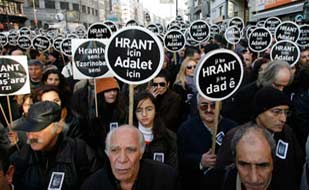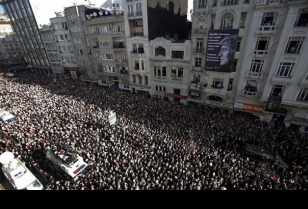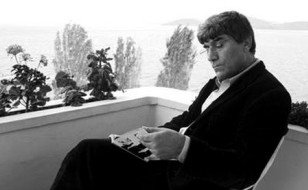The murder of Turkish-Armenian journalist Hrant Dink in Istanbul a year ago has not been forgotten in Turkey. Indeed, as the trial of the young murder suspects is going on, new evidence pointing to a much more coordinated organisation of the murder emerges nearly weekly.
"For Hrant, for Justice"
Thus, the crowd of over ten thousand who gathered in front of the office of Dink’s Agos newspaper in Istanbul on Saturday, at the time and on the spot of his murder a year ago, was not only mourning an outspoken proponent of dialogue between Turkey and Armenia, but also protesting against the lack of investigation of the real forces behind the murder. There were other gatherings and protests in other major cities in Turkey, too. The slogan was "For Hrant, for Justice."
Internationally, newspapers reported on the commemoration gathering. The German Frankfurter Allgemeine Zeitung ran two articles on 21 January, one covering the gathering, and one on Hrant Dink’s last article, in which he described himself as a “restless pigeon”, looking in all directions for possible threats.
A spate of attacks by young nationalists
The taz newspaper published an article entitled “Silence for Hrant Dink”, in which it reported on the ten thousand mourners, as well as a concert held in Hrant Dink’s memory in Istanbul in the evening. The article quoted human rights activist and writer Arundhati Roy, who was with Hrant Dink’s widow Rakel Dink during the commemoration, as saying that it was Hrant Dink’s death which had drawn international attention to the Armenian question.
The article was generally pessimistic about the state of affairs in Turkey, citing a list of attacks on Christians: the murder of Italian priest Andrea Santoro, who was killed by a 17-year old in Trabzon in February 2006, an attack on another priest who was injured five months later, then Hrant Dink’s murder, then the gruesome murder of three Christians working for the Zirve Publishers in April 2007, an attack on a priest in Izmir in December 2007, and another attack prevented in Antalya.
The newspaper quoted Orhan Cengiz, lawyer in the Malatya case, as saying that the profile of the perpetrators is the same in each case: they were all young, male members of youth groups of the Nationalist Movement Party (MHP) or Great Union Party (BBP). Older associates were also linked to these parties, and before the crimes were committed, there were “dubious contacts to police or military circles.” Cengiz also pointed out that evidence was often withheld, meaning that the “men behind the scene” could not be investigated either in the Malatya or the Dink murder case.
The same issue of the taz also published an article on the flag which school children made out of their own blood, citing this as another example of the rise in Turkish nationalism.
Only "small fry" in court
The German Die Welt newspaper conducted an interview with Fethiye Cetin, lawyer of the Dink family, in Istanbul before the anniversary and also summarised the murder, reactions and the trial in a series of 28 pictures. The newspaper said that only the “small fry" were in court, and that the real forces behind the murder had not been touched. Cetin spoke of her conviction that the Trabzon group of suspects must have had logistic support in Istanbul. She interpreted Dink’s murder as an attempt to put a stop to the democratisation process in Turkey and predicted that the trial would last for years.
Call for reform of Penal Code
The British Times newspaper published an open letter to the editor, in which the Article 19, English PEN and Index on Censorship organisations call on Turkey to reform its Penal Code. The letter predicts that the planned amendments of the controversial Article 301, under which Hrant Dink himself was tried and sentenced, would “prove inadequate.”
Suspicion of "negligence, even collusion"
The New York Times reported on the commemoration gathering and said:
“Hrant Dink had sought to encourage reconciliation between Turkey and Armenia, but several years before his death he was prosecuted under Turkish law for describing the early 20th-century mass killings of Armenians as genocide.”
The newspaper added that there was suspicion of “official negligence, or even collusion” in the murder, and that the Dink family mistrusted the ongoing investigation.
Commemorative events around the world
The first anniversary of Hrant Dink’s murder was also marked with cultural and religious events internationally.
On 18 January, a panel entitled “Freedom of Expression and Association & Article 301 and the Murder of Hrant Dink” was held in Frankfurt. On the same day, a requiem was performed for Hrant Dink in Washington D.C., and historian Taner Akcam held a speech. Another requiem was organised in California, preceded by wreath-laying in front of Armenian memorial monuments.
The Visual Anthropology Club of the Central European University in Budapest remembered Hrant Dink with a viewing of the film “Swallow’s Nest”, in which Hrant Dink speaks about an Armenian orphanage in the outskirts of İstanbul. The same film was also shown in Ottawa, Canada.
In Berlin, a vigil was held in front of the Turkish consulate, while the Monument of Innocents in London was the site of another commemorative event. There was another gathering in Cologne, and a photo exhibition of Hrant Dink’s life in Berlin.
These are just a few examples of the many events organised in memory of Hrant Dink; there were more in Germany and Britain, as well as Belgium, the Netherlands and France. (AG)
* Information about the commemorative events was taken from the http://www.hranticinadaleticin.com/en/events.php website.






